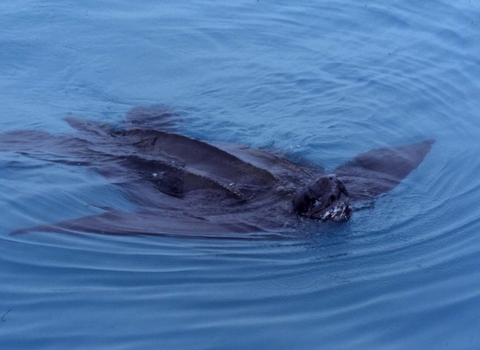
Leatherback turtle ©Mike Dains
Leatherback turtle
Scientific name
Dermochelys coriaceaWhen to see
May to SeptemberSpecies information
Category
Statistics
Length: Up to 2.5m Weight: 250-700kg Lifespan: up to 100 yearsConservation status
Habitats
About
This giant of the sea turtle world travels alone, only coming together with other turtles to breed. They lay their eggs on beaches and leave them unsupervised, leaving the baby turtles to make their way to the sea alone once they hatch. These unique animals are specially adapted to be able to cope with colder seas, which means they are able to dive to great depths in order to hunt deep sea jellyfish. They have an incredible (and slightly gruesome) way of making sure they never lose a meal – they have downward facing spines inside their throat that stops prey getting out! Unfortunately, the leatherback turtle can get confused and accidentally eat plastic bags or balloons as they look like jellyfish. These plastic items then get stuck in their throats and can cause serious health problems for the turtle.How to identify
A large black turtle with white dots all over the body, flippers and head. They have a lighter underbelly with a pink colouration on the underthroat and chin. Their front flippers can reach 2.5m. Other sea turtle species rarely visit UK waters, but are distinct from leatherbacks as they have a hard shell and are green/brown in colour. Leatherbacks lack a hard shell and have leathery skin covering their backs.Distribution
A rare sight off West Coasts in summer months, very rarely spotted elsewhere in UK seas.Did you know?
Leatherback turtles don't have a hard, bony shell like other sea turtles, instead their backs are covered by the thick, leathery layer of skin that gives them their name.How people can help
Report your leatherback turtle sightings to your local Wildlife Trust. If you spot a leatherback turtle at sea, maintain a distance of 100m. If the turtle approaches you, maintain a constant speed and allow them to interact on their own terms and leave at will. Sea turtles don't come ashore on UK beaches like they do on their tropical nesting beaches, so a turtle on a UK beach is in trouble. If you find a stranded turtle (dead or alive), please report it to the relevant authority. The Wildlife Trusts are working with Government to improve fishing practices and eliminate marine pollution. You can support our work by joining your local Wildlife Trust, helping at a local beach clean, saying no to balloon releases and plastic bags and choosing sustainably sourced fish.



